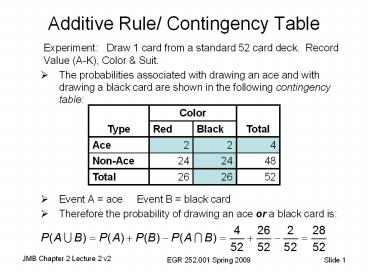Additive Rule/ Contingency Table PowerPoint PPT Presentation
Title: Additive Rule/ Contingency Table
1
Additive Rule/ Contingency Table
- Experiment Draw 1 card from a standard 52
card deck. Record Value (A-K), Color Suit. - The probabilities associated with drawing an ace
and with drawing a black card are shown in the
following contingency table - Event A ace Event B black card
- Therefore the probability of drawing an ace or a
black card is
Type Color Color Total
Type Red Black Total
Ace 2 2 4
Non-Ace 24 24 48
Total 26 26 52
2
Short Circuit Example - Data
- An appliance manufacturer has learned of an
increased incidence of short circuits and fires
in a line of ranges sold over a 5 month period. A
review of the defect data indicates the
probabilities that if a short circuit occurs, it
will be at any one of several locations is as
follows - The sum of the probabilities equals _____
Location P
House Junction (HJ) 0.46
Oven/MW junction (OM) 0.14
Thermostat (T) 0.09
Oven coil (OC) 0.24
Electronic controls (EC) 0.07
3
Short Circuit Example - Probabilities
- If we are told that the probabilities represent
mutually exclusive events, we can calculate the
following - The probability that the short circuit does not
occur at the house junction is - P(HJ) 1 - P(HJ) 1 0.46 0.54
- The probability that the short circuit occurs at
either the Oven/MW junction or the oven coil is - P(OM U OC) P(OM)P(OC) 0.14 0.24 0.38
4
Conditional Probability
- The conditional probability of B given A is
denoted by P(BA) and is calculated by - P(BA) P(B n A) / P(A)
- Example
- S 1,2,3,4,5,6,7,8,9,11
- Event A number greater than 6 P(A) 4/10
- Event B odd number P(B) 6/10
- (BnA) 7, 9, 11 P (BnA) 3/10
- P(BA) P(B n A) / P(A) (3/10) / (4/10) 3/4
5
Multiplicative Rule
- If in an experiment the events A and B can both
occur, then - P(B n A) P(A) P(BA)
- Previous Example
- S 1,2,3,4,5,6,7,8,9,11
- Event A number greater than 6 P(A) 4/10
- Event B odd number P(B) 6/10
- P(BA) 3/4 (calculated in previous slide)
- P(BnA) P(A)P(BA) (4/10)(3/4) 3/10
6
Independence Definitions
- If in an experiment the conditional probabilities
P(AB) and P(BA) exist, the events A and B are
independent if and only if - P(AB) P(A) or P(BA) P(B)
- Two events A and B are independent if and only if
P A n B P(A) P(B)
7
Independence Example
- A quality engineer collected the following data
on 100 defective items produced by a manufacturer
in the southeast
Problem/Shift Electrical Mechanical Other
Day 20 15 25
Night 10 20 10
- What is the probability that the defective items
were associated with the day shift? - P(Day) (201525) / 100 .60 or 60
- What was the relative frequency of defectives
categorized as electrical? - (20 10) / 100 P(Electrical) .30
- Are Electrical and Day independent?
- P(E n D) 20 / 100 .20 P(D) P(E)
(.60) (.30) .18 - Since .20 ?.18, Day and Electrical are not
independent.
8
Serial and Parallel Systems
- For increased safety and reliability, systems are
often designed with redundancies. A typical
system might look like the following
If components are in serial (e.g., A B), all
must work in order for the system to work.
If components are in parallel, the system works
if any of the components work.
9
Serial and Parallel Systems
1
- What is the probability that
- Segment 1 works?
- A and B in series
- P(AnB) P(A) P(B) (0.95)(0.9) 0.855
- Segment 2 works?
- C and D in parallel will work unless both C and D
do not function - 1 P(C) P(D) 1 (0.12) (0.15)
1-0.018 0.982 - The entire system works?
- Segment 1, Segment 2 and E in series
- P(Segment1) P(Segment2) P(E)
0.8550.9820.97 0.814
2

